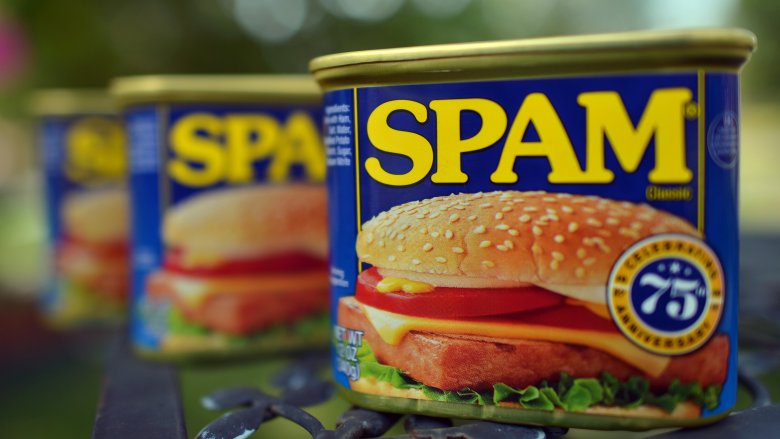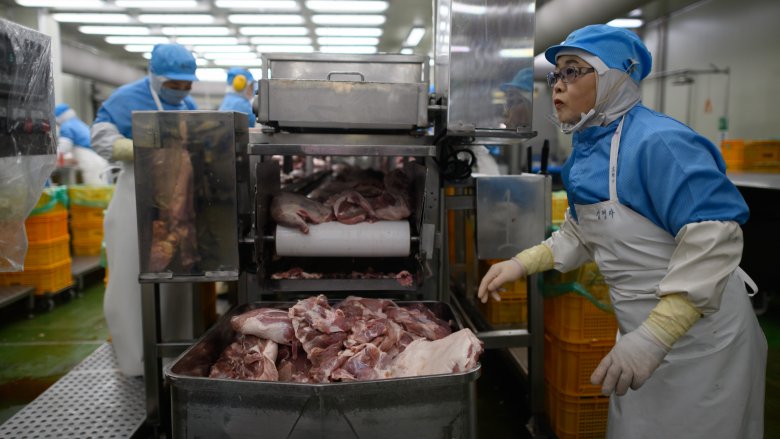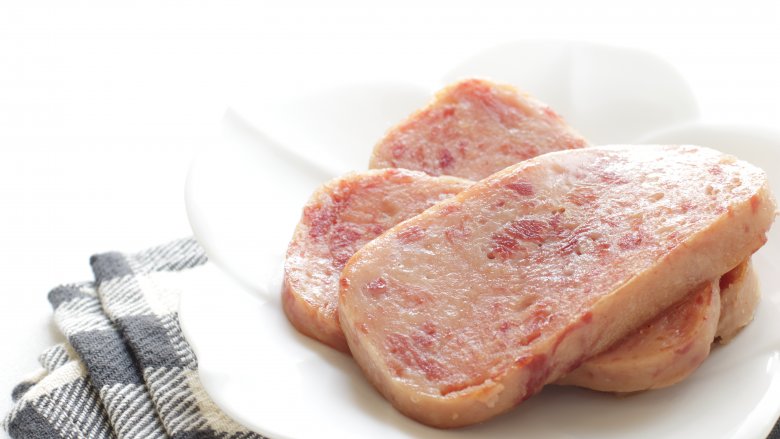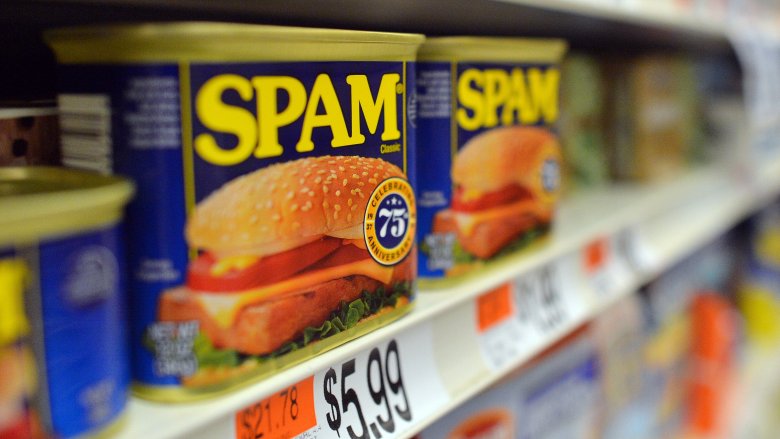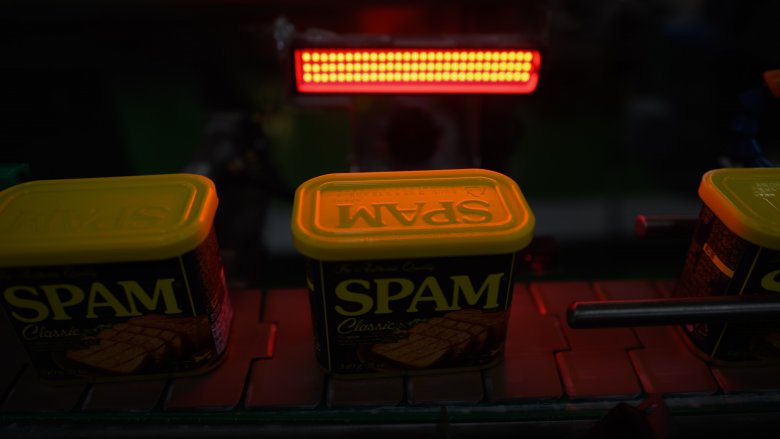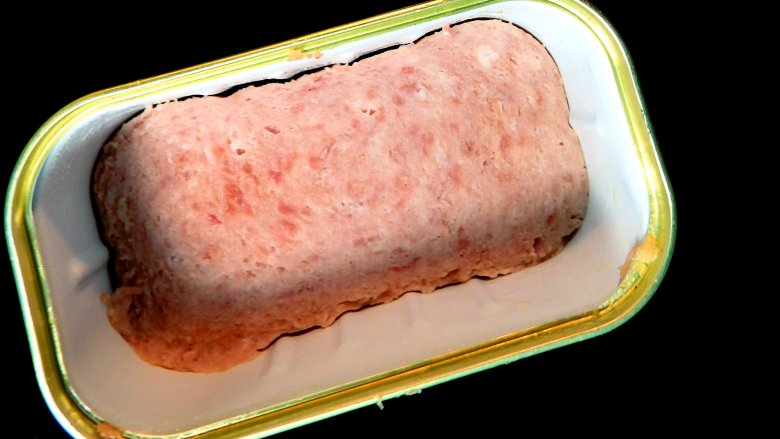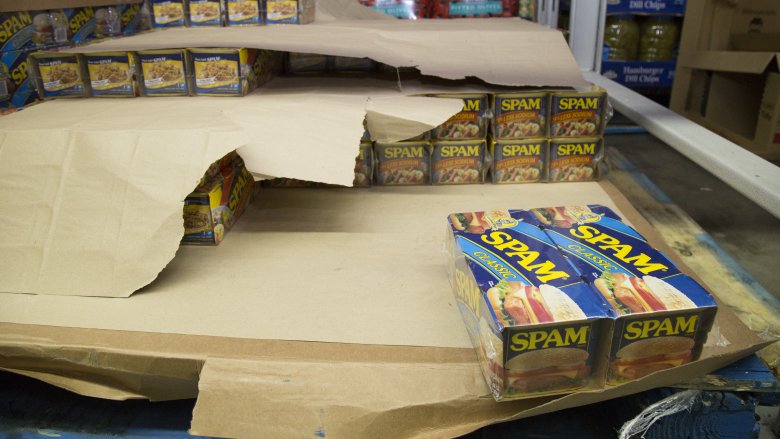This Is How Spam Is Really Made
Spam turned 80 years old on July 5, 2017. It's had a massively long history, says the Smithsonian, and it all started with a naming contest where Hormel asked the public just what they should call their new product. The answer came from a man named Kenneth Daigneau, and there's a "but." Sure, he's the one credited for naming Spam, but he was also a bit of an insider: he was the brother of Hormel's vice president. It's impossible to say whether or not that had anything to do with it, but regardless, we have Spam today.
Spam always enjoyed some serious popularity, first a hit among Depression-era families, then later forming the basis of World War II-era plans to feed Allied troops. They're the ones that spread it all over the world, bestowing upon this rather ordinary tin of meat a sense of patriotism, American ingenuity, and versatile affordability.
It's all about the "brand experience," and Spam proves that's a powerful thing. Because let's face it — it's weird stuff. It might look like a block of mystery meat and taste suspiciously delicious, but it turns out there's a lot that goes into each and every can of Spam.
Why is Spam... Spam?
Spam is a weird thing, a tin of long-lasting, weirdly-textured, inexplicably good... meat product. But there's actually a story behind why it is, and according to Eater, it started when Jay Hormel took over as president of the company his father founded. That was in 1929, and all good entrepreneurs know you're always on the lookout for the next big thing. Hormel saw it in the deli case of stores, where they sold canned lunch meat by the slice. It was originally formed into six-pound molds, and customers who wanted some had it sliced at the deli. Hormel figured if he could make it smaller, customers could buy their own little brick.
It was Hormel employee named Julius Zillgitt who came up with the 12-ounce can that's so familiar today, and he's also the one that helped develop the process of getting the meat into the can — which was more complicated than you might think.
Hormel also wanted to set his product — and his company — apart from all the rest, so he decided that he was only going to use pork shoulder. It was a brilliant move: not only was he going to create a reputation of not using waste products like pig lips and noses, but he was going to be using a section of the pig that was so hard and time-consuming to process, it rarely got used, says How Products Are Made. It was a total win.
The meat for Spam is separated and processed at the factory
For a long time, Spam was made in two places: a factory in Fremont, Nebraska and another in Austin, Minnesota, says How Stuff Works. But according to the Star Tribune, things have changed. In 2018, Hormel sold their Nebraska plant to WholeStone Farms, LLC, a consortium of hog farmers. They would continue to sell their products to Hormel for three years after the deal, and potentially (but not definitely) beyond. When it comes to international Spam, though, that's made overseas in factories in South Korea, the Philippines, and Denmark (via the Austin Daily Herald).
According to Mother Jones, the processing of meat for Spam — and other Hormel products — starts on the kill floor of Quality Pork Processors, Inc. The plant hasn't been without its issues, as they report workers had a tendency to develop autoimmune disorders, particularly those working with the pigs' heads. It's an almost mind-numbingly efficient assembly line where the slaughtered pigs are broken down one piece at a time, and we're talking about a lot of pigs. According to Bloomberg (via Marketplace), 20,000 pigs are processed into Spam each and every day.
All Spam's ingredients are mixed
Spam has an image of being mostly a weird sort of mystery meat, but there's only six ingredients: pork (with ham), salt, water, potato starch, sugar, and sodium nitrite. That's it! There's also nothing that sounds weird or unfamiliar, as even if you're not sure what some of these things do, you've undoubtedly seen them in other foods.
According to How Products are Made, Spam starts looking less like pigs and more like Spam when the meat is sliced from the bone — a process done by hand — and ground into 8,000-pound batches. A metal detector is used to make sure nothing has gotten into the batch in any part of the process, and then it's transferred to a series of vacuum mixers that are capable of super-chilling the batch to freezing. The rest of the ingredients are dumped in, the mixer is sealed to be airtight, and it's mixed. Why the cold and the vacuum? It's to help prevent a huge amount of liquid from being released when the meat is cooked.
And here's why those ingredients are in Spam
You're familiar enough with the basics, like salt and sugar. But what is the point of some of the other stuff?
First, sodium nitrite. You may have heard that condemned in popular media as carcinogenic, but according to the World Cancer Research Fund (via the BBC), it's not so much the compounds as it is the prep and cooking methods. When nitrites are mixed into something high in amino acids then cooked, that's when nitrosamines form and that's what has been linked to cancer.
So, why include them? They prevent the growth of bacteria that can cause food poisoning if it's ingested, and no one wants their Spam with a side of botulism. They're also what gives Spam that distinctive pink color, thanks to a chemical reaction that happens between the nitrites and the protein in the meat.
What about potato starch? Wired says that's included because the long cooking time of Spam would otherwise leave the contents incredibly dry, and the potato starch helps preserve moisture as well as, LiveScience says, hold the whole thing together. And that's a recent addition to the recipe, only showing up in 2009 to also help get rid of that unappetizing layer of gelatin (via Smithsonian).
And why do they describe it as "pork, with ham"? That describes the two cuts of meat used: pork shoulder and ham, which is the preserved and cured leg of the pig.
The Spam cans are filled and sealed
Here's where things get a little weird. The still-raw pork mixture is funneled through a few filling machines until it gets to the cans. According to How Products are Made, a machine scoops up the raw Spam and pushes it into the can from the bottom. It's sealed, stamped, and sent on its way.
Clearly, they're not raw when you get them, so what gives? According to Wired, vacuum-sealing the raw pork product first and cooking it in the cans is what gives Spam that super-long shelf life and makes it pretty much perfect for keeping on the shelf until you get that once-every-few-years craving. (Or, you know, until the world ends and civilization as we know it crumbles around us.)
And it took a long time to get that canning process right. Before Hormel's extensive experimentation, canned meat would end up as dry inside but still surrounded in water. Hormel figured out not just the canning process, says How Stuff Works, but also the right amount of salt and the right temperature to cook at.
The Spam cans head to the cooker
After the cans of Spam are, well, canned, their next stop is a massive hydrostatic cooker. The scale is crazy: the machine is a full six stories tall, says How Products are Made, and it's full of very, very hot water.
The cans of raw Spam approach on a conveyor, and are pushed onto a shelf 24 at a time. That shelf moves the cans through a series of chambers within the cooker, where they're cooked, and sterilized, then washed, and finally cooled. There are 11 chambers, and by the time cans complete their journey from beginning to end they're almost ready to be sent on their way.
Not only is it a huge machine, but it's fast, too: 33,000 cans an hour can be processed through the cooker. That seems like a crazy amount, but it's keeping up with an almost insane amount of Spam sold. According to LiveScience, Hormel tries to keep up with an estimated three cans sold every second.
After that, they're labeled, boxed, and shipped to a grocery store near you.
Spam is packaged up in gift sets in Korea
Everyone's familiar with those distinctive blue and yellow cans, right? Absolutely, and that's what makes it so surprising that there's an extra step that goes into the making of Spam in South Korea: it's often packaged up as part of a gift set.
The New York Times looked at South Korea's favorite gifts for the Lunar New Year. It was a list that includes things like rare tea, imported wines, fine cuts of beef... and Spam. They even quoted a saleswoman at a high-end department store in Seoul who described it this way: "Here, Spam is a classy gift you can give to people you care about during the holiday."
How did this happen? Spam went to Korea with American troops during the Korean War, and at the time, the only way to get meat was through American Army post exchange stores. It was something that became associated with the wealthy that could afford it, and it's remained that way. Budaejigae, or military stew, is a hugely popular dish that's part Spam, part kimchi. It's helped build a $235 million-a-year industry, along with their gift boxes.
In 2014, the local Spam producer put 1.6 million gift box sets on the shelves, for "occasions of important when one wishes to pay special honor and proper respect."
The process makes Spam last a long, long time
It's no secret that Spam lasts a long time, and that almost freakish longevity might be part of the reason people are sort of suspicious of it. Hormel actually recommends it be included in emergency preparedness kits, not just because of the long shelf life but because it's fully cooked and doesn't need to be heated. (It's not the only one of their products you can say that about, and they also recommend their Dinty Moore stew, their Chi-Chi's line, and their Hormel chili.)
So, how long does it really last?
Indefinitely, says Hormel; "as long as the seal has remained intact, unbroken, and securely attached." They do note that flavor and freshness will start to decline about three years after it's made, but say it's still perfectly safe to eat. Eat By Date says Spam starts to go a little off after about 5 years past the date, and says that storing them in the pantry at around 75 degrees Fahrenheit will help extend the shelf life. Bottom line? Might want to restock your apocalypse kit every five years or so. Future you will thank past you!
There's been a shocking amount of Spam sold
Spam hit the shelves on the very nearly patriotic day of July 5, 1937. Since then, there's been some shocking numbers associated with them, starting with World War II.
The Allied army ran on Spam, and according to Time, they sent around 15 million cans of Spam a week to the soldiers, to the tune of around 100 million cans by the time the war was over. It's no wonder it was so closely associated with the war effort.
It's also no wonder that the one billionth can of Spam rolled out of the factory in 1959, and when it did, sales were only on the increase. Fast forward a few decades, and Marketplace says that by 2017, more than 8 billion cans have been sold. That's way more than just a mere ton of Spam — literally, as it just takes 2,666 cans of Spam to equal one ton. There's no signs that interest in Spam is going away anytime soon, either, as it shows up in an estimated one in three American households.
Guam loves their Spam
Think Spam's a hit in your household? There's a good chance you don't have anything on Guam, because according to the Pacific Daily News, a huge number of the cans that roll out of the Spam factory end up in Guam. How many? Enough that Guam residents average 16 cans of Spam per person, per year. You can even get it at McDonald's: there are six in Guam, and they go through about 400 cases of Spam a month. (That's 57,600 cans a year!)
Why? Because tinned luncheon meat — particularly Spam — has long been associated with the end of a dark time in their history: their occupation by Japanese forces during World War II. Along with liberation, Allied forces brought Spam — and when you've been starving under the boot heel of an occupying army, Spam is life.
Survivors of the liberation remember scrounging through the jungle for scraps to eat: "Food that even the pigs wouldn't eat, we would eat," said one. So when Marines came and started giving out tins of Spam, it was a huge deal. The Allied landing was in July 1944 and fresh supplies didn't show up until December, but Spam? Spam saw them through.
